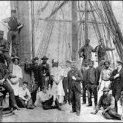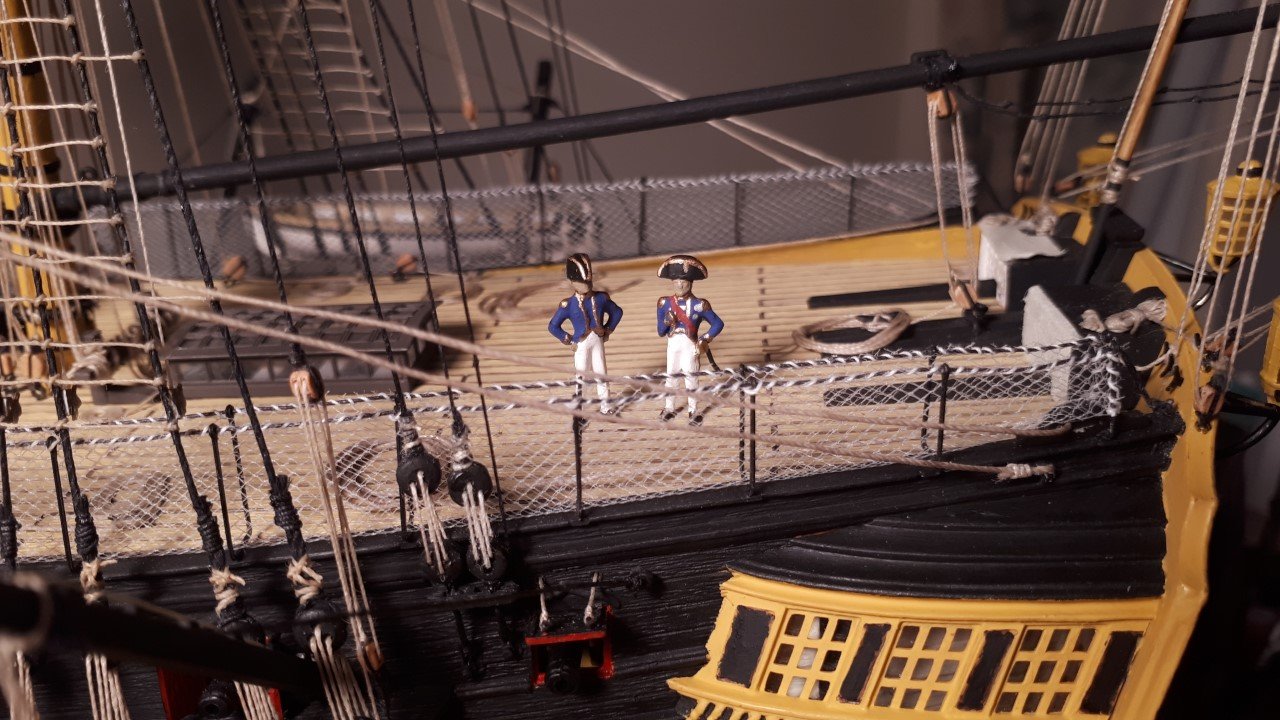-
Posts
2,115 -
Joined
-
Last visited
Content Type
Profiles
Forums
Gallery
Events
Everything posted by Ian_Grant
-
I too returned to the hobby after making several ships, including the CS, in the 70's. It has been a source of much satisfaction. To whet your appetite for the big Heller kit, here are a couple of in-progress shots of my Victory to show what can be done with plastic. I bought it in 1982 and it sat on a shelf for decades. There are several sheets of brass etch enhancements available now; I bought two of them. Most people take years for her, I took five working on and off. Bill97 built her very quickly, see his log.
- 248 replies
-
- Cutty Sark
- Revell
-
(and 2 more)
Tagged with:
-
Vitus, if you become hooked on ship models, you might like to try a Heller Victory which is hands down the best plastic sailing ship model extant. She is well worth the bother of serving shrouds and stays as appropriate.
- 248 replies
-
- Cutty Sark
- Revell
-
(and 2 more)
Tagged with:
-
Underhill's excellent book is entitled "Masting and Rigging the Clipper Ship and Ocean Carrier". It has many excellent diagrams of ironwork on yards and masts, and rigging details but is not specific to CS. I believe there is an AOTS Cutty Sark (may be wrong). There is also a little book by Noel Hackney on CS; I've never seen it but his book on Victory is very good, though under-rated in my opinion. By the way I see no one answered your question about the bars running along the tops of the yards (or did I miss it?). They're called jackstays and the head of the sail was attached to them, not the actual yard. Good luck with your build. She's a beautiful ship. This is the 1/96 scale model, correct?
- 248 replies
-
- Cutty Sark
- Revell
-
(and 2 more)
Tagged with:
-
Very nice Shields 2.0 Glen! Regarding plastic rivet heads, I thought they might work for a Soleil Royal build with wale bolt heads but the smallest I found with a cursory look were 0.040" DIA probably too big for your SIB's.
-
Dave, if you want to see an impressive ship, check out "Royal Clipper" which is a modern 5-master inspired by Preussen, and which offers cruises in the Med or Caribbean. I mentioned early in this log that we took a week's cruise aboard her. Awesome!! (I have no association with Star Clippers).
-
Hi Dave; When I built my Revell Cutty Sark in the 70's as a naive teenager I just used model glue to attach all my "coils" to belaying pins. That hasn't failed either which is almost unbelievable to me! I used CA on my Heller Victory build too, even though I read some warnings on MSW about using CA on rigging. Some people are quite adamantly against it but my Victory seems ok so far. I sure would like to get on and finish this build (I know exactly where to display her). I've been seduced by another build, a Roman galley for radio control, after interrupting Preussen to experiment on oar drive mechanisms. I don't see a log for your Pamir, but I find the search engine a bit problematic; I'm sure it's just me. Do you have one....if not I'd love to see your work! Not too many windjammers hereabouts! Regards, Ian
-
Could double-sided tape have held the pre-severed and filed flat heads while you painted them?
-
As I start the bow skinning I have to use smaller pieces of ply to divide the compound curves into smaller, weird quadrilaterals and trapezoids. Spacing between framing members is also smaller so I can't fit clamps to the inside, therefore I started using small ply battens and air-nailing temporarily to the frame through the ply. I put masking tape on the battens so they wouldn't end up glued on. The first couple of pieces went ok but on the third most of the 23ga pin nails snapped when I tried to pry them back out. I've reverted to 18ga which won't snap, but could splinter bulkheads if I miss centre, sigh. Trying to shoot most of them into wales and stringers. It's not a pretty sight and it's too bad the resulting holes will be bigger than the 23ga, but I'm sure the filling/smoothing stage will hide all sins. Here's a piece I just added. It's slow going: template the next piece using clear vellum paper, bandsaw out, test fit and adjust, glue on, wait 25 minutes to remove the battens, pull any remaining 18ga brads, scrape off glue squeeze-out before it fully sets, then on to the next.
- 536 replies
-
- Quadrireme
- radio
-
(and 1 more)
Tagged with:
-
Or a Spitfire. (Supermarine I mean; not Triumph!) 😉
- 536 replies
-
- Quadrireme
- radio
-
(and 1 more)
Tagged with:
-
LOL! It's 1/32" "bending plywood". It has a core and two face layers, with a preferred bending axis. A local specialist hardwood/plywood place sells it in 50" x 50" sheets, or half sheets one of which I bought. It's pretty thin, but firms up when in a bend. I plan to epoxy the inside, same as my old RC boats, which will strengthen and waterproof it. Still wondering about epoxying the outside; may depend on the weight after skinning/epoxying. Might just spar varnish the outside then sand before painting. Come to think of it may just spar varnish inside too to avoid the fumes.
- 536 replies
-
- Quadrireme
- radio
-
(and 1 more)
Tagged with:
-
Fairing completed, apart from a lingering wobble along the starboard stern bulwark which I will fix later. I added pieces of pine between bulkheads bow and stern, at deck level, before fairing. First two pieces of the ply skin glued in place, without a single cuss word 🤙. These were the easy two, wale-to-wale on the lower hull where the cross section is constant, requiring bending along only one axis. Plan is to do bow and stern in three bands: keel to wale, wale to deck level, bulwark. Horizontal seams will be covered by the outer wale, or trim pieces. Next pieces of ply midships will run from wale to outrigger bottom and contain holes for lower oars. Then I'll need to build the outriggers and a ventilation course above them. Not sure how to do that, yet. I wish now I hadn't made the keel quite so tall in section. Would have saved some weight and made more space. I expect many cuss words will be employed during bow and stern skinning.
- 536 replies
-
- Quadrireme
- radio
-
(and 1 more)
Tagged with:
-
Bill, another thing that can be done on these bulwarks is to score the missing planking lines across the blank background around the carvings. Easy to say, harder to do. 😄
- 1,508 replies
-
- Le Soleil Royal
- Heller
-
(and 1 more)
Tagged with:
-
Glen, you keep saying "will need to be attached inside the bottle".........it's going to be an epic insertion process!
-
Further on Hackney's diagram, I didn't annotate everything at the time so here is more info: 31 = eyebolt for use by Fore royal backstay 32 = eyebolt for use by main royal backstay 33 = eyebolt for use by mizzen royal backstay 34 = eyebolt for strop to single block on fore topsail yard halyard 72 = " " " " " main " " " 80 = " " " " " mizzen " " " (starboard only) Longridge has full text descriptions of all these, of course.
-
You might be able to do that if you rotate the ladders 90 degrees?
- 1,508 replies
-
- Le Soleil Royal
- Heller
-
(and 1 more)
Tagged with:
-
Good work. I'll reiterate that I really like your deck plank painting.
- 1,508 replies
-
- Le Soleil Royal
- Heller
-
(and 1 more)
Tagged with:
-
Longridge shows them in the big fold-out plans 6 & 7 and mentions them in the individual text descriptions of the routing of affected lines. Unfortunately he doesn't have a detailed drawing of the channels. Here's a picture from Noel Hackney's little book (much under-rated IMHO) showing deadeyes and blocks on each channel. The numbers are reference numbers for rigging lines; you can see my annotations. Hope this helps.
-
My old printed instructions show the same. It does seem odd, even though you'd only have to step off to one side as you came up. Thanks Bill for raising all these issues to get answers before I ever touch my SR!! 😃
- 1,508 replies
-
- Le Soleil Royal
- Heller
-
(and 1 more)
Tagged with:
-
Bill, I think there is some confusion about the term "cambered". Cambered does not mean "raised above deck level", it means "having a convex surface". After Marc glued two layers of gratings together, he sanded a side-to-side curve on the top as he showed in his photo with the sanding block in the background. The grey 2nd layer is tapered to zero thickness along the side edges.
- 1,508 replies
-
- Le Soleil Royal
- Heller
-
(and 1 more)
Tagged with:
About us
Modelshipworld - Advancing Ship Modeling through Research
SSL Secured
Your security is important for us so this Website is SSL-Secured
NRG Mailing Address
Nautical Research Guild
237 South Lincoln Street
Westmont IL, 60559-1917
Model Ship World ® and the MSW logo are Registered Trademarks, and belong to the Nautical Research Guild (United States Patent and Trademark Office: No. 6,929,264 & No. 6,929,274, registered Dec. 20, 2022)
Helpful Links
About the NRG
If you enjoy building ship models that are historically accurate as well as beautiful, then The Nautical Research Guild (NRG) is just right for you.
The Guild is a non-profit educational organization whose mission is to “Advance Ship Modeling Through Research”. We provide support to our members in their efforts to raise the quality of their model ships.
The Nautical Research Guild has published our world-renowned quarterly magazine, The Nautical Research Journal, since 1955. The pages of the Journal are full of articles by accomplished ship modelers who show you how they create those exquisite details on their models, and by maritime historians who show you the correct details to build. The Journal is available in both print and digital editions. Go to the NRG web site (www.thenrg.org) to download a complimentary digital copy of the Journal. The NRG also publishes plan sets, books and compilations of back issues of the Journal and the former Ships in Scale and Model Ship Builder magazines.





